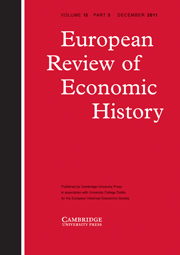Crossref Citations
This article has been cited by the following publications. This list is generated based on data provided by
Crossref.
Hale, Matthew
Hawkins, Richard
and
Wright, Catherine
2006.
List of publications on the economic and social history of Great Britain and Ireland published in 2005.
The Economic History Review,
Vol. 59,
Issue. 4,
p.
788.
PRATT, DAVID
SCHOFIELD, P. R.
FRENCH, HENRY
KIRBY, PETER
FREEMAN, MARK
GREAVES, JULIAN
and
PEMBERTON, HUGH
2007.
Review of periodical literature published in 2005.
The Economic History Review,
Vol. 60,
Issue. 1,
p.
136.
Rollings, Neil
2007.
British business history: A review of the periodical literature for 2005.
Business History,
Vol. 49,
Issue. 3,
p.
271.
Marks, Daan
2010.
Unity or diversity? On the integration and efficiency of rice markets in Indonesia, c. 1920–2006.
Explorations in Economic History,
Vol. 47,
Issue. 3,
p.
310.
Chilosi, David
and
Volckart, Oliver
2011.
Money, States, and Empire: Financial Integration and Institutional Change in Central Europe, 1400–1520.
The Journal of Economic History,
Vol. 71,
Issue. 3,
p.
762.
Federico, G.
2011.
When did European markets integrate?.
European Review of Economic History,
Vol. 15,
Issue. 1,
p.
93.
FEDERICO, GIOVANNI
2012.
How much do we know about market integration in Europe?1.
The Economic History Review,
Vol. 65,
Issue. 2,
p.
470.
Hynes, William
Jacks, David S.
and
O'rourke, Kevin H.
2012.
Commodity market disintegration in the interwar period.
European Review of Economic History,
Vol. 16,
Issue. 2,
p.
119.
Stürmer, Martin
2013.
150 Years of Boom and Bust - What Drives Mineral Commodity Prices?.
SSRN Electronic Journal,
Chilosi, David
Murphy, Tommy E.
Studer, Roman
and
Tunçer, A. Coşkun
2013.
Europe's many integrations: Geography and grain markets, 1620–1913.
Explorations in Economic History,
Vol. 50,
Issue. 1,
p.
46.
Batten, Jonathan A.
Szilagyi, Peter G.
and
Wagner, Niklas F.
2015.
Should emerging market investors buy commodities?.
Applied Economics,
Vol. 47,
Issue. 39,
p.
4228.
Batten, Jonathan A.
Szilagyi, Peter G.
and
Wagner, Niklas
2015.
Should Investors Buy Commodities?.
SSRN Electronic Journal,
Crucini, Mario J.
and
Smith, Gregor W.
2016.
Early Globalization and the Law of One Price: Evidence from Sweden, 1732-1914.
East Asian Economic Review,
Vol. 20,
Issue. 4,
p.
427.
Constantin, Cristian
2016.
Romanian–British Commercial Exchanges at the Lower Danube: The Consular Report of Percy Sanderson on the Year 1883.
Hiperboreea,
Vol. 3,
Issue. 2,
p.
103.
Stuermer, Martin
2017.
Industrialization and the demand for mineral commodities.
Journal of International Money and Finance,
Vol. 76,
Issue. ,
p.
16.
Stuermer, Martin
2018.
150 YEARS OF BOOM AND BUST: WHAT DRIVES MINERAL COMMODITY PRICES?.
Macroeconomic Dynamics,
Vol. 22,
Issue. 3,
p.
702.
Murray, John E.
and
Silvestre, Javier
2020.
Integration in European coal markets, 1833–1913†.
The Economic History Review,
Vol. 73,
Issue. 3,
p.
668.
Solar, Peter M.
2022.
Prices: sources, problems, solutions.
Financial History Review,
Vol. 29,
Issue. 3,
p.
287.
Gunessee, Saileshsingh
and
Zhang, Cheng
2022.
The economics of domestic market integration.
Journal of Economic Surveys,
Vol. 36,
Issue. 4,
p.
1069.
Jopp, Tobias A.
and
Spoerer, Mark
2024.
Handbook of Cliometrics.
p.
231.


